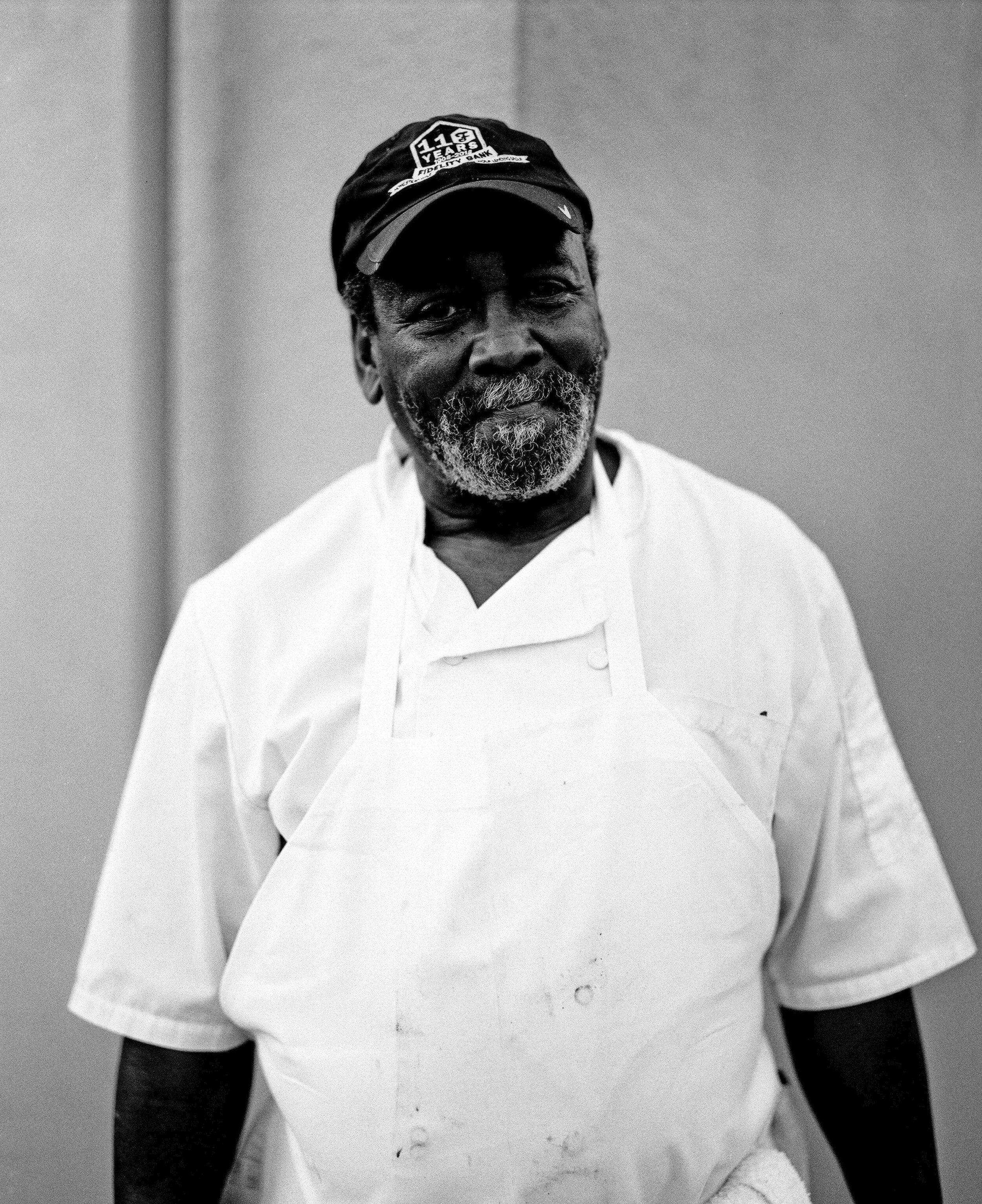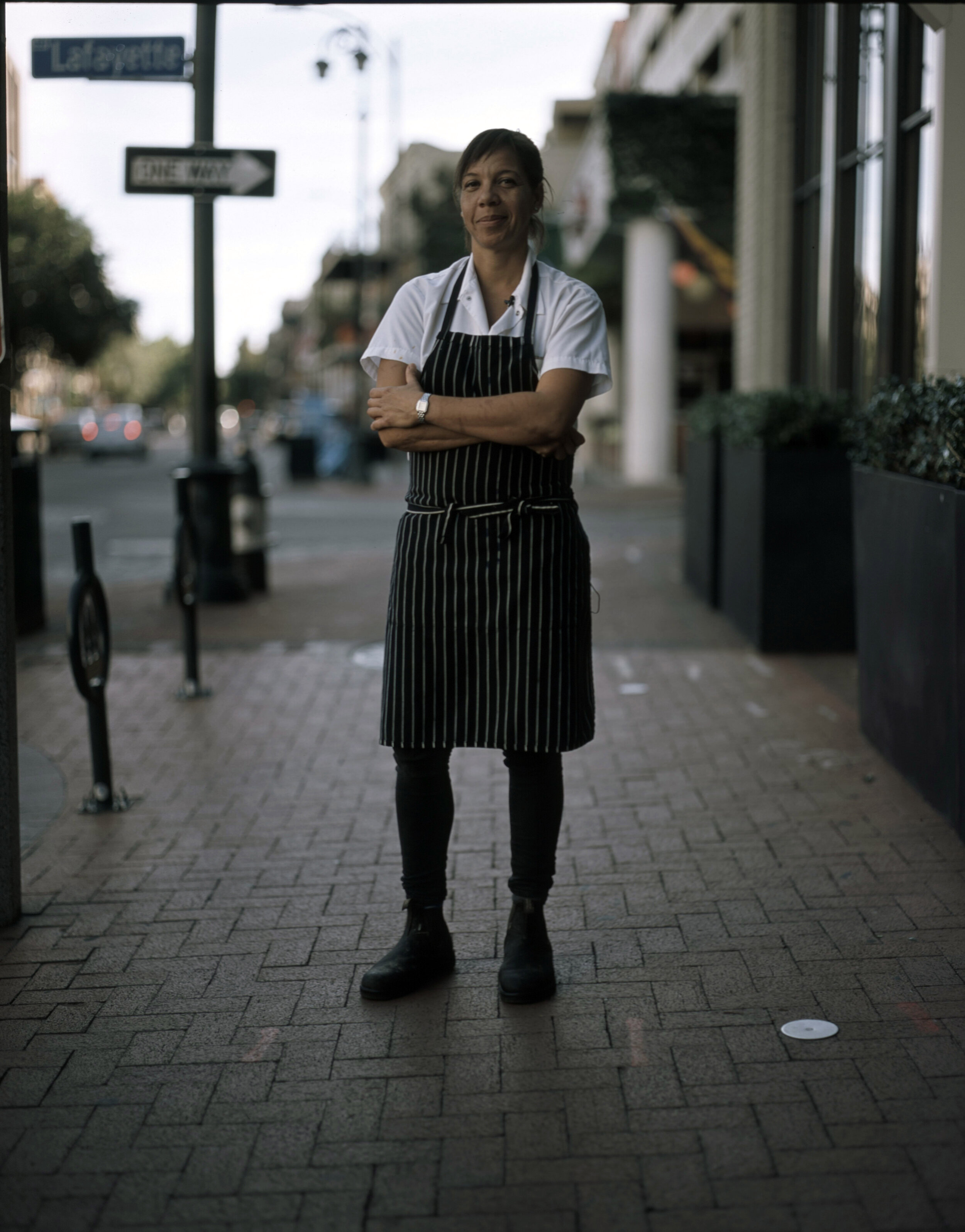On Nov. 4, 2019, filmmaker Lino Asana and photographer Josh Farria gathered roughly two dozen black chefs to be photographed in New Orleans’ Congo Square. Inspired by the 1978 cookbook Creole Feast, they sought to document Black chefs and cooks’ enduring impact on New Orleans restaurant cuisine. The following portraits are from that session.
By Lolis Eric Elie | Photos by Josh Farria
A book begins with its cover. And in this case the cover was a revolution.
Nathaniel Burton, on the dust jacket of Creole Feast: 15 Master Chefs of New Orleans Reveal Their Secrets, looked every inch the man he was — chef’s toque atop his head, chef’s jacket on his back, restaurant menu in his hand, serious look on his face.
This wasn’t Rastus smiling at you from the Cream of Wheat box, nor was it your gentle Uncle Ben of converted rice fame. This man was a professional expressing the seriousness with which he took his profession.
Chef Joe Randall saw something of himself in that image when the book came out in 1978. Never before had he seen a Black culinary professional on the cover of a book representing himself and his profession with such dignity. The Savannah chef bought the book immediately and treasures it still.
Ernest “sKeeter” jack Jr. of Antoine’s Restaurant
Chef Greg Daniels of Dickie Brennan’s Steakhouse
Lino Asana, a Cameroonian American filmmaker based in Oakland, California, had a similar reaction. He discovered Creole food when visiting New Orleans with his girlfriend, pastry chef Kaitlin Guerin. He first saw a copy of Creole Feast at Guerin’s uncle’s house.
“There’s that thing that happens when you see that book. Nathaniel Burton on the front cover just had this presence,” Asana recalls. “I had just never seen a Black cook or chef like that before.
“At that point, I had already started trying to figure out why there were so many similarities between New Orleans and Cameroon. Most American food was really weird to me. I’ve been here since I was a teenager, but I’d never found any place here that reminded me so much of where I was from.
“The book didn’t necessarily go too deeply into the food. It was mostly about the chefs. But it raised some questions,” he says. “I figured the chefs would make a good documentary, and through that, I could also learn about my connection with the food and the culture.”
Bon Ton Cafe, which closed in March 2020, was reminiscent of many older New Orleans restaurants where a team of Black women ran the kitchen. Dot Hall was head chef for decades. Here are three of her colleagues: Mary Phelps (at stove with spatula), Joyce Owens (preparing a plate), and Willena Benjamin.
For three years, Asana has been working on “A Hand in the Pot,” a documentary inspired by Creole Feast. Its narrative will be organized around the planning and shooting of a photograph of roughly two dozen Black chefs and cooks in historic Congo Square in New Orleans. The project is not unlike the iconic 1958 “A Great Day in Harlem” photograph of jazz musicians. To that end, he’s teamed with New Orleans-born photographer Josh Farria and cinematographer Jeremy Obertone.
Asana’s work is but the most recent effort to breathe new life into Creole Feast.
Rudy Lombard, the mastermind and co-author of Creole Feast, had worked with my father, attorney Lolis Edward Elie, in the civil rights movement. The two men shared a love of freedom and fine dining. When the book and the festivals it spawned were happening, I was a teenager eager for more information and recipes to feed my growing hunger for culinary knowledge.
Uncle Rudy and I talked for years about a new edition of the book.
In the waning months of his life, he had similar conversations with his brother, Edwin Lombard, an appeals court judge in New Orleans.
“He said that there was a lot of chefs he wished he could have included at the time. Some he’d left out, like Eddie Baquet and Michael Roussel. It wasn’t intentional. It was just that he had to start to cut down for editorial reasons,” Edwin Lombard recalls of his brother Rudy.
“He was concerned about other recipes from cooks who weren’t professional cooks, like my mother’s recipes and my aunt’s recipes,” Edwin Lombard says. “He wanted me to go out and get some more recipes and feature cooking in New Orleans and how it came down through time.”
By then, the pancreatic cancer that would kill Rudy Lombard was already ravaging his body. He died in December 2014.
Chef Milton Prudence of Annunciation
Chef Philip (Skip) Lomax Jr. of Mr. B’s Bistro
In the decades since the book’s publication, a lot has changed on the American food scene. Chefs at fine dining restaurants are no longer nameless, faceless “domestic workers,” as the U.S. Bureau of Labor Statistics classified them until 1977. Some are celebrities whose faces are as familiar as those of many movie stars and newscasters.
The fine dining kitchens of New Orleans — in which many of the chefs and most of the cooks had traditionally been Black — now are largely peopled with white culinary school graduates and newly arrived Americans from our neighboring countries to the south.
“French, Spanish, Cajun, Italian — all these ethnic groups live in New Orleans, but they are not running the kitchens of the best restaurants in the city. The single, lasting characteristic of Creole cuisine is the Black element,” Rudy Lombard wrote more than 40 years ago in the book’s introduction.
“It is unfortunate that local attitudes toward racial matters have not allowed the contribution of Black people to this cuisine to achieve the kind of preeminence they deserve. Commentary on this subject has traditionally been lacking in good taste,” he wrote.
“Southern cookbooks, especially those on New Orleans cooking, are heavily inundated with irreverent and whimsical language about Blacks, while several of the popular older cookbooks simply omit any reference to Blacks in their description of the origins and influences of Creole cuisine.”
Chef Nina Compton, outside her restaurant, Compère Lapin.
Zella Palmer, the chair and director of Dillard University’s Ray Charles Program in African-American Material Culture, has sought to correct this record and extend the legacy of Creole Feast. She created the Dr. Rudy Joseph Lombard Black Hand in the Pot lecture series and produced a documentary, “The Story of New Orleans Creole Cooking: The Black Hand in the Pot,” which features the food memories of New Orleans Creoles.
Asana’s work differs in that it focuses on the chefs. In addition to the photograph of Burton on the cover of Creole Feast, the book includes photos of all the featured chefs, usually at work in their kitchens. Asana took inspiration from that.
Chef Isadore Pilart has worked at Mandina’s Restaurant for 35 years.
Well aware of the financial challenges facing documentary films, he hoped that a stand-alone series of photographs could serve to document the lives and work of these chefs until the film is completed.
“I wanted the photographs to feel like you couldn’t tell in what era they were taken. I didn’t want the photos to look like today,” Asana says. “By shooting in black and white, the original photographer for the book [Frank Lotz Miller] focused mainly on the chefs and not so much on the food, and that was our focus, too.”
Photographer Farria says, “I wanted to just capture the real people, and what it is about them that influences the food and the culture of the kitchen.”
While Asana’s documentary is still very much a work in progress, these photos can stand on their own as testament to the enduring significance of Creole Feast and the Black chefs in the professional kitchens of New Orleans.
This story was published in Issue No. 1 of The Bitter Southerner magazine.
Header Photo: Ernest “Skeeter” Jack Jr. has worked at Antoine’s Restaurant since high school. He’s the restaurant’s executive chef, saucier.
Lolis Eric Elie is a journalist and television writer. Most recently, he co-authored Rodney Scott's World of Barbecue: Every Day Is a Good Day: A Cookbook.
Josh Farria is a photographer from New Orleans currently living in Brooklyn, New York.












